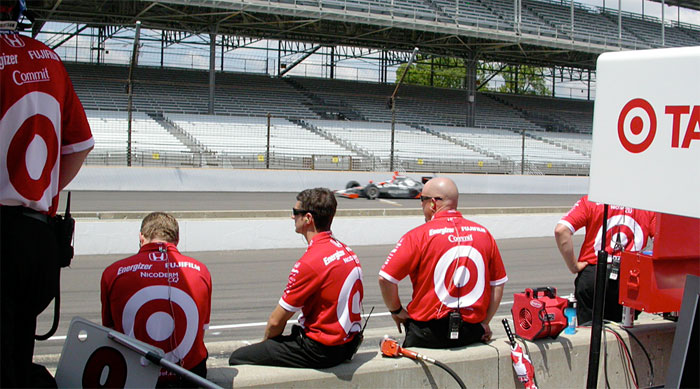“During the run-up to the 2004 presidential election, much was made of the fact that 2.4 million new jobs had been created that year. Omitted was the fact that close to 800,000 of those jobs went to Hispanics who had been here less than a year.”
We live in a world of obfuscation.
Yes, there are problems presented to our nation each and every day, but no real answers are provided and every interested party is blaming the other for what is wrong at the moment.
So, instead of offering another in-depth news story on Britney Spears’ latest pregnancy or Michael Jackson’s Bahrain hideaway, it might be more valuable to focus on the many issues that have not been resolved, the kind that impact and worry the average American.
Category: Culture
$2,489 vs $971 Revenue Per Square Foot

photo by ifoapplestore.
Steve Lohr takes an interesting look at Apple’s retail store initiatives (high end, expensive locations, large open spaces and lots of space to play with the goodies), their inspiration and performance:
“We had to design an experience that was as big as the space,” said Mr. Johnson, 47, who is senior vice president in charge of the stores. “When your product line is the size of a conference table, that is a real risk.”
Taking that risk has paid off handsomely so far. Since it opened its first two stores five years ago today, the Apple chain has become a retailing phenomenon. Necessity and inspiration led Apple to toss out the conventional textbook on computer stores and to ignore the rules of location, design, staffing and services provided.
Revenue for each square foot at Apple stores last year was $2,489, compared with $971 at Best Buy, the big computer and electronics retailer, according to Forrester Research, a market research firm.
This evening, Apple is opening a showcase store in Manhattan that will burnish the company’s reputation for clever design. The entrance to the store, on Fifth Avenue between 58th and 59th Streets, is a glass cube, 32 feet on each side, with a suspended Apple logo inside. Customers walk down a circular staircase — or take a cylindrical glass elevator — to the 10,000-square-foot store below. The store will be open 24 hours a day, seven days a week — a first for Apple and an acknowledgment of New York’s status as a round-the-clock city.
A Speedy Visit to the “Honda Powered” Indy 500

I recently had an opportunity to briefly visit the Indianapolis Motor Speedway (home of the Memorial Day weekend Indy 500 [satellite view]) while the teams were practicing. A surprisingly large crowd was on hand to watch the drivers, mechanics and managers test their vehicles, systems and methods. Many, but not all teams had quite a number of computer operators keeping an eye on all aspects of their cars.

Silence.
There’s not much of that at the Speedway, but when it does occur – only a split second – it is jarring.

Danica Patrick easily grabbed most of the crowd’s attention. A group of fans and photographers never left her team’s side. More photos here.
You did read that right. Honda powers all of the cars in this year’s race. Evidently Honda has dominated recently and the teams coalesced on their engine this year.
La Femme: French Politics = Madison’s Political Climate?
There’s a reason that the leaders of France’s Socialist Party are called “elephants”: They live forever. Among the elephants now vying to become the party’s candidate for president in next year’s election are Laurent Fabius, who served as prime minister 22 years ago, and Lionel Jospin, who served as Socialist Party leader a quarter-century ago and suffered a defeat in the last presidential election so devastating, both for himself and for the party, that you would have thought prudence alone would dictate political retirement. But in France, politics is a profession; once you arrive, you stay.
No one has thought to call Ségolène Royal an elephant. For one thing, it would be unbecoming, since she is a woman — and a woman who, when she works her smile up into her eyes, bears a passing resemblance to Audrey Hepburn. Royal is, remarkably enough, the first truly présidentiable woman in French history. But what is most striking about her candidacy, which so far consists of a highly orchestrated media seduction, is not the fact that she is a woman but rather that she has positioned herself as a nonelephant, indeed, almost an antielephant. She is, in effect, running against France’s political culture, which is to say against remoteness and abstraction, ideological entrenchment and male domination itself. And that culture, which is embodied by her own party, has struck back, ridiculing her as a soap bubble borne aloft by a momentary gust of public infatuation.
I was struck by the similarities between the French “Establishment” and the local political establishment vis a vis newcomers/challengers.
The Race to Catalog Sears Homes
Marilyn Raschka spends many of her weekends driving around unfamiliar neighborhoods, knocking on doors and talking her way into strangers’ basements. Once downstairs, she breaks out her flashlight and shines it along exposed beams, hunting for a letter and some numbers that are each no bigger than a thumbprint.
The 61-year-old resident of Hartford, Wis., is part of a small cadre of historians and passionate amateurs on a mission to identify and protect homes made by Sears, Roebuck and Co. About 70,000 to 100,000 of them were sold through Sears catalogs from 1908 to 1940. Distressed that the houses are falling victim to the recent boom in teardowns and renovations, their fans are scouring neighborhoods across the country, snapping pictures and sometimes braving snakes and poison ivy to poke around basements and attics for the telltale stamps that mark the lumber in most of the catalog homes. Because people can be shy about the state of their basements, Ms. Raschka brings along photos of her own messy cellar to persuade them to let her in.
There are some Sears homes around Madison.
Colbert’s White House Correspondent’s Speech
An excerpt from the annual White House Correspondents Association dinner. Comedian Stephen Colbert made humorous … all » remarks about various current events and the relationship between the press and the White House. He also presented a video of a mock press conference which ended in a chase scene featuring long-time correspondent Helen Thomas.
More on Colbert.
Wal-Mart’s Site Selection Process & Distribution Economics
The placement of Wal-Mart stores has followed a spatial diffusion model. K-Mart, in contrast, scattered its stores across the country. Here is more. Here is a video showing the spread of Wal-Mart, well worth watching and short. It is the best single lesson in economic geography you will receive. Thanks to http://kottke.org for the pointer.
Vail at the Crossroads
Nancy and I skied Vail years ago. It is a great mountain, but the term “village” really doesn’t apply any longer. Jared Jacang Maher asks if they must tear down a local landmark to save it. There’s been no shortage of controversy, including the defeat of two council members:
Crossroads not only stands at one of the town’s most prominent intersections, it’s a convergence point for wealth, power and mountain-sized egos, for small-town politics with big-city politicking. The official arguments may focus on topics like height and zoning, but citizens on both sides of the debate see the struggle as more epic, as a fight between Vail’s old-time founders and its younger newcomers for what the town is and what it should become. Emotions are high, and the stakes are huge. Because despite its theme-park attributes, Vail is a real place, with real residents who live and work here, who are born and die here, and who love and hate each others’ guts — all within town limits.
Like the facades of many of Vail’s early buildings, Crossroads is faded and cracked after decades of exposure to sunlight and snow. Built in 1969 on the East Meadow Drive corridor, the 60,000-square-foot, horseshoe-shaped complex wraps around a parking lot with three stories of condos sitting above a ground floor of retail. The two biggest tenants — Clark’s Market and the Crossroads Cinema — both pulled out last month, citing slow business and deteriorating facilities.
Reminds me a bit of the local Whole Foods / Hilldale / Sentry Foods battle.
Organic Goes Mainstream
Thirteen-and-a-half million servings of organic romaine, radicchio and baby greens. That’s how much Earthbound Farm, the biggest organic produce company in the country, sends across America from its gigantic San Juan Bautista processing plant every single week.
That’s one big bowl of salad — way bigger than when Myra and Drew Goodman started Earthbound Farm in their Carmel Valley living room in 1984. They now farm 26,000 organic acres.
Madison Miscellany Keeps Getting Better
Jason, Kristian, Bill and others have done an excellent job with their daily Madison link roundup. Hands down, the best look at what’s happening locally. Well done!